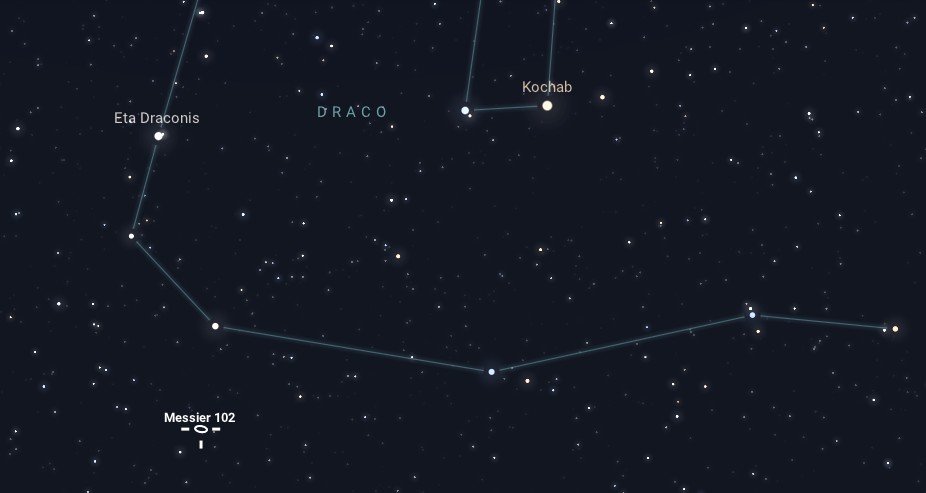The Spindle Galaxy, cataloged as Messier 102 (M102) or NGC 5866, is a lenticular galaxy located in the constellation Draco. Discovered by Pierre Méchain in March 1781, there has been historical confusion and debate among astronomers regarding the true identity of the galaxy. Some argue that M102 corresponds to the Spindle Galaxy (NGC 5866), due to its spindle-like appearance, while others suggest it might be a duplicate observation of M101 or a different object altogether. Despite these historical uncertainties, NGC 5866 is widely accepted as the best candidate for M102.
Structure and Appearence
M102 is situated approximately 44 million light-years away from Earth and is notable for its edge-on orientation as seen from our vantage point. Its disk appears as a thin, elongated spindle shape in the sky, characterized by a prominent dust lane that bisects its central bulge. This dust lane is indicative of ongoing star formation and obscures part of the galaxy’s central region from view. The overall appearance of NGC 5866 is typical of lenticular galaxies, which are intermediate in shape between spiral and elliptical galaxies.
The Spindle Galaxy spans about 60,000 light-years in diameter, making it significantly smaller than some other large spiral galaxies like the Milky Way or Andromeda. Despite its smaller size, NGC 5866 exhibits a well-defined structure, with a central bulge surrounded by a flattened disk of stars, gas, and dust. Observationally, its edge-on orientation allows astronomers to study the distribution of stars and gas along its disk more easily, providing insights into the galaxy’s dynamics and evolutionary history.
Virgo Cluster
M102 is a member of the Virgo Cluster of galaxies, a rich collection of over 2,000 galaxies located about 60 million light-years away. Its membership in this cluster places it within a region of space where interactions between galaxies are common, influencing their shapes, star formation rates, and overall evolution. Studying galaxies like M102 within the Virgo Cluster helps astronomers understand the broader context of galactic environments and the effects of clustering on galaxy properties.
In summary, M102, serves as a fascinating astronomical object due to its distinctive edge-on appearance and its location within the Virgo Cluster. Despite its historical ambiguity as M102, NGC 5866 stands out for its spindle-shaped structure, edge-on orientation, and its contributions to our understanding of galaxy formation and evolution in dense galactic environments.
Observation
The Spindle Galaxy is best observed during the spring to early summer months in the Northern Hemisphere. March to May offer good visibility for galaxies in the constellation Draco, where M102 is located. During this period, the constellation is well-placed in the northern sky during the evening hours. Around April and May, Draco reaches its highest point in the sky during the night, providing the best opportunity to observe the galaxy under darker skies with less atmospheric interference.

Observing M102 typically requires at least a small to medium-sized telescope. Larger telescopes provide more detailed views, while astrophotography equipment can capture its features with even greater clarity and depth.
With a small telescope (3-4 inches), M102 appears as a faint, elongated smudge of light. The galaxy’s spindle-like shape and some details may be discernible under good viewing conditions, particularly dark skies. A medium-sized telescope (6-8 inches) provides better resolution and can reveal more structural details of the galaxy. The edge-on orientation and central dust lane become more apparent, offering a clearer view of its lenticular shape. A large telescope (10 inch aperture) will offer the best view of NGC 5866. It will resolve finer details within the galaxy, such as its central bulge, dust lane, and possibly hints of its outer halo and fainter regions.
Capturing images of NGC 5866 requires a camera attached to a telescope or a dedicated astrophotography setup. Long-exposure images can reveal intricate details and faint structures within the galaxy, enhancing our understanding of its morphology and composition.



